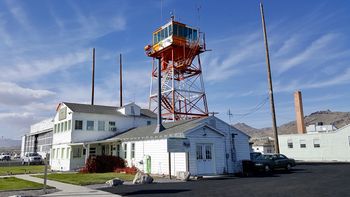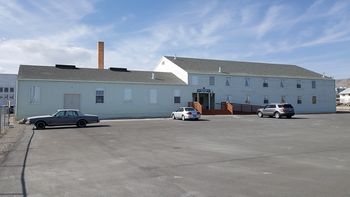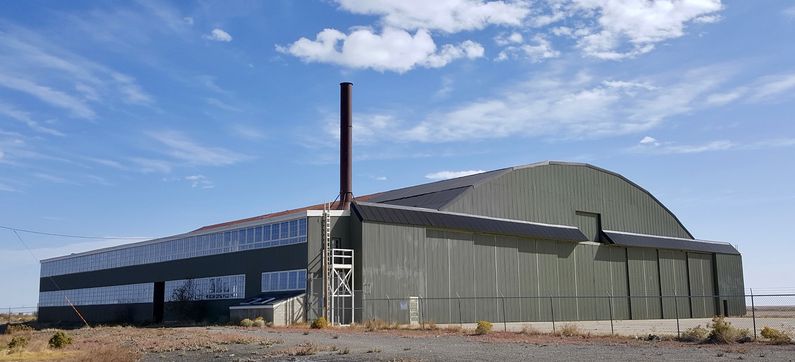Wendover Air Force Base
|
Wendover Air Force Base (1940-1969) - A United States Air Force Base first established in 1940 as Wendover Army Air Field at Wendover, Tooele County, Utah. Renamed Wendover Air Force Base in 1947 and Wendover Air Force Auxiliary Field in 1958. Closed in 1969. Also known as Wendover Field.
Pre World War II(Text & table adapted from USAF Fact Sheet) On 20 Sep 1940 an agreement was reached on the 1,560,000 acre site as work commenced on the required personnel facilities at Wendover. Construction of the bombing range began on 4 Nov 1940. President Franklin Roosevelt authorized the expansion of the Wendover range in February 1941, increasing its size by 262,200 acres. That spring the War Department allotted $1 million for grading, drainage, paving, and night lighting projects at Wendover. In the summer a Bombing and Gunnery Range Detachment was activated as a sub-post of Fort Douglas in Salt Lake City. In 1941 the field sported four 63-man barracks, a 250-man mess hall, officers' quarters, an administration building, a telephone exchange, two ordnance warehouses, a bombsight storage building, and dispensary. There were also three ammunition igloos and four powder magazines. A power system with its own generating plant was also under construction, as was a railroad spur and water and sewer systems. World War II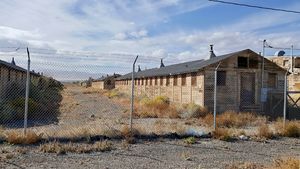 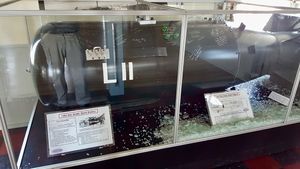 For much of the war Wendover was the Army Air Forces' only bombing and gunnery range. Heavy bomber crews from all over the country converged on the burgeoning airfield for training before being assigned to overseas bases. On 1 Mar 1942 the Army Air Force activated Wendover Air Base and also assigned the research and development of guided missiles, pilotless aircraft, and remotely-controlled bombs to the site. The new base was supplied and serviced by the Ogden Air Depot at Hill Field. A mock enemy city was constructed near the mountains on the base using salt from the nearby Bonneville Salt Flats. This made a fine practice target for the many bomber crews, as did the life-sized enemy battleships and other targets elsewhere on the range. Many of the targets were even electrically illuminated for night practice. Machine gun ranges allowed gunners to either fire at moving targets from stationary gun emplacements or fire at stationary targets from three machine guns mounted on a railroad car moving along a section of track at up to 40 miles per hour (Wendover's famous "Tokyo Trolley"). By late 1943 there were approximately 2,000 civilian employees and 17,500 military personnel at Wendover. Construction at the base continued for most of the war, and by May 1945 the base consisted of 668 buildings, including a 300-bed hospital, gymnasium, swimming pool, library, chapel, cafeteria, bowling alley, two movie theaters, and 361 housing units for married officers and civilians. Wendover played a pivotal role in winning the war against Japan by training the crews that carried the Atomic Bombs to their targets. The "Enola Gay" and "Bocks Car" B-29s flew from Wendover to the advanced base on Tinian Island in the Pacific for their missions. The hanger that housed the "Enola Gay" and the aircrews is under restoration.
Post World War IIFollowing the war, the Army Air Force activated a testing facility at Wendover Army Air Base to evaluate captured munitions and rocket systems, such as the German V-1 Buzz Bomb. Special teams also performed tests on newly developed weapon systems. In the summer of 1946 the Ogden Air Technical Service Command assumed jurisdiction over all operations at Wendover Field except engineering and technical projects. Over the next few years jurisdiction of the facility passed back and forth between various commands of the Air Force. Cold WarIn the early 1950s the 25th Air Depot Wing, stationed at Hill AFB, sent elements to Wendover to coordinate and arrange for aerial gunnery practice for several fighter squadrons based at Hill. The Air Force transferred command jurisdiction of Wendover AFB to the Tactical Air Command on 1 Oct 1954. TAC's 9th Air Force used the Wendover range for gunnery practice and the base itself as a mobility staging area, while the Ogden Air Materiel Area at Hill AFB continued to provide administrative and logistical support. On 1 Jan 1958 USAF transferred jurisdiction of Wendover back to OOAMA. Later that month Wendover Air Force Base was renamed Wendover Air Force Auxiliary Field. ClosureIn August 1961 the Air Force inactivated Wendover Air Force Auxiliary Field and placed it in "caretaker status." In August 1977 Hill AFB turned over most of Wendover Air Force Auxiliary Field to the town of Wendover, Utah, retaining only a 164 acre radar site on the old base. Current StatusTooele County, Utah, assumed ownership of the airport and base buildings in 1998, and the County continues to operate the airfield as a public airport. The Historic Wendover Airfield Foundation operates a museum and gift shop in the restored Officer's Service Club. The operations building and the control tower have also been restored. The hanger that housed the "Enola Gay" and the aircrews is under restoration and looks good externally. Many buildings remain from the WWII era and some are interpreted with large Historic Markers that picture and explain their functions. The USAF radar site still occupies the site at the west end of the cantonment area.
See Also: Sources: Links: Visited: 15 Oct 2016
| |||||||||||||||||||||||||||||||||||||||||||||||||||||||||||||||||||||||||||||||||||||||||||||||||||||||||||||||||||||||||
